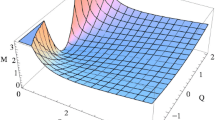Abstract
We consider the generalized laws of thermodynamics in massive gravity. Making use of explicit black hole solutions, we devise black hole merger processes in which i) total entropy of the system decreases ii) the zero-temperature extremal black hole is created. Thus, both second and third laws of thermodynamics are violated. In both cases, the violation can be traced back to the presence of negative-mass black holes, which, in turn, is related to the violation of the null energy condition. The violation of the third law of thermodynamics implies, in particular, that a naked singularity may be created as a result of the evolution of a singularity-free state. This may signal a problem in the model, unless the creation of the negative-mass black holes from positive-mass states can be forbidden dynamically or the naked singularity may somehow be resolved in a full quantum theory.
Similar content being viewed by others
References
N. Arkani-Hamed, H. Georgi and M.D. Schwartz, Effective field theory for massive gravitons and gravity in theory space, Ann. Phys. 305 (2003) 96 [hep-th/0210184] [SPIRES].
N. Arkani-Hamed, H.-C. Cheng, M.A. Luty and S. Mukohyama, Ghost condensation and a consistent infrared modification of gravity, JHEP 05 (2004) 074 [hep-th/0312099] [SPIRES].
S.L. Dubovsky, Phases of massive gravity, JHEP 10 (2004) 076 [hep-th/0409124] [SPIRES].
V.A. Rubakov, Lorentz-violating graviton masses: getting around ghosts, low strong coupling scale and VDVZ discontinuity, hep-th/0407104 [SPIRES].
S.L. Dubovsky, P.G. Tinyakov and I.I. Tkachev, Cosmological attractors in massive gravity, Phys. Rev. D 72 (2005) 084011 [hep-th/0504067] [SPIRES].
S. Dubovsky, P. Tinyakov and M. Zaldarriaga, Bumpy black holes from spontaneous Lorentz violation, JHEP 11 (2007) 083 [arXiv:0706.0288] [SPIRES].
M.V. Bebronne and P.G. Tinyakov, Black hole solutions in massive gravity, JHEP 04 (2009) 100 [arXiv:0902.3899] [SPIRES].
V.A. Rubakov and P.G. Tinyakov, Infrared-modified gravities and massive gravitons, Phys. Usp. 51 (2008) 759 [arXiv:0802.4379] [SPIRES].
S.W. Hawking, Gravitational radiation from colliding black holes, Phys. Rev. Lett. 26 (1971) 1344 [SPIRES].
J.D. Bekenstein, Black holes and entropy, Phys. Rev. D 7 (1973) 2333 [SPIRES].
S.W. Hawking, Particle creation by black holes, Commun. Math. Phys. 43 (1975) 199 [Erratum ibid. 46 (1976) 206] [SPIRES].
J.M. Maldacena and A. Strominger, Statistical entropy of four-dimensional extremal black holes, Phys. Rev. Lett. 77 (1996) 428 [hep-th/9603060] [SPIRES].
A. Strominger and C. Vafa, Microscopic origin of the Bekenstein-Hawking entropy, Phys. Lett. B 379 (1996) 99 [hep-th/9601029] [SPIRES].
S.L. Dubovsky and S.M. Sibiryakov, Spontaneous breaking of Lorentz invariance, black holes and perpetuum mobile of the 2nd kind, Phys. Lett. B 638 (2006) 509 [hep-th/0603158] [SPIRES].
B. Feldstein, Spontaneous Lorentz violation, negative energy and the second law of thermodynamics, Phys. Rev. D 80 (2009) 044020 [arXiv:0904.1212] [SPIRES].
S. Mukohyama, Ghost condensate and generalized second law, JHEP 09 (2009) 070 [arXiv:0901.3595] [SPIRES].
S. Mukohyama, Can ghost condensate decrease entropy?, Open Astron. J. 3 (2010) 30 [arXiv:0908.4123] [SPIRES].
J.D. Bekenstein, Relativistic gravitation theory for the MOND paradigm, Phys. Rev. D 70 (2004) 083509 [astro-ph/0403694] [SPIRES].
E. Sagi and J.D. Bekenstein, Black holes in the TeVeS theory of gravity and their thermodynamics, Phys. Rev. D 77 (2008) 024010 [arXiv:0708.2639] [SPIRES].
Z. Berezhiani, D. Comelli, F. Nesti and L. Pilo, Exact spherically symmetric solutions in massive gravity, JHEP 07 (2008) 130 [arXiv:0803.1687] [SPIRES].
S.L. Dubovsky, P.G. Tinyakov and I.I. Tkachev, Massive graviton as a testable cold dark matter candidate, Phys. Rev. Lett. 94 (2005) 181102 [hep-th/0411158] [SPIRES].
M.V. Bebronne and P.G. Tinyakov, Massive gravity and structure formation, Phys. Rev. D 76 (2007) 084011 [arXiv:0705.1301] [SPIRES].
J.M. Nester, A new gravitational energy expression with a simple positivity proof, Phys. Lett. A 83 (1981) 241 [SPIRES].
E. Witten, A new proof of the positive energy theorem, Comm. Math. Phys. 80 (1981) 381 [SPIRES].
P. Schoen and S.T. Yau, On the proof of the positive mass conjecture in general relativity, Comm. Math. Phys. 65 (1979) 45 [SPIRES].
P. Schoen and S.T. Yau, Positivity of the total mass of a general space-time, Phys. Rev. Lett. 43 (1979) 1457 [SPIRES].
N. Arkani-Hamed, H.-C. Cheng, M.A. Luty, S. Mukohyama and T. Wiseman, Dynamics of gravity in a Higgs phase, JHEP 01 (2007) 036 [hep-ph/0507120] [SPIRES].
R.M. Wald, Black hole entropy is the Noether charge, Phys. Rev. D 48 (1993) 3427 [gr-qc/9307038] [SPIRES].
V. Iyer and R.M. Wald, Some properties of Noether charge and a proposal for dynamical black hole entropy, Phys. Rev. D 50 (1994) 846 [gr-qc/9403028] [SPIRES].
M. Visser, Dirty black holes: entropy as a surface term, Phys. Rev. D 48 (1993) 5697 [hep-th/9307194] [SPIRES].
T. Jacobson, G. Kang and R.C. Myers, On black hole entropy, Phys. Rev. D 49 (1994) 6587 [gr-qc/9312023] [SPIRES].
V. Iyer and R.M. Wald, A comparison of Noether charge and euclidean methods for computing the entropy of stationary black holes, Phys. Rev. D 52 (1995) 4430 [gr-qc/9503052] [SPIRES].
J.M. Bardeen, B. Carter and S.W. Hawking, The four laws of black hole mechanics, Commun. Math. Phys. 31 (1973) 161 [SPIRES].
R. Wald, General relativity, University of Chicago Press, Chicago U.S.A. (1984).
S. Dubovsky, T. Gregoire, A. Nicolis and R. Rattazzi, Null energy condition and superluminal propagation, JHEP 03 (2006) 025 [hep-th/0512260] [SPIRES].
D. Comelli, F. Nesti and L. Pilo, Stars and (furry) black holes in Lorentz breaking massive gravity, arXiv:1010.4773 [SPIRES].
Author information
Authors and Affiliations
Corresponding author
Additional information
ArXiv ePrint: 1102.0479
Rights and permissions
About this article
Cite this article
Capela, F., Tinyakov, P.G. Black hole thermodynamics and massive gravity. J. High Energ. Phys. 2011, 42 (2011). https://doi.org/10.1007/JHEP04(2011)042
Received:
Revised:
Accepted:
Published:
DOI: https://doi.org/10.1007/JHEP04(2011)042




